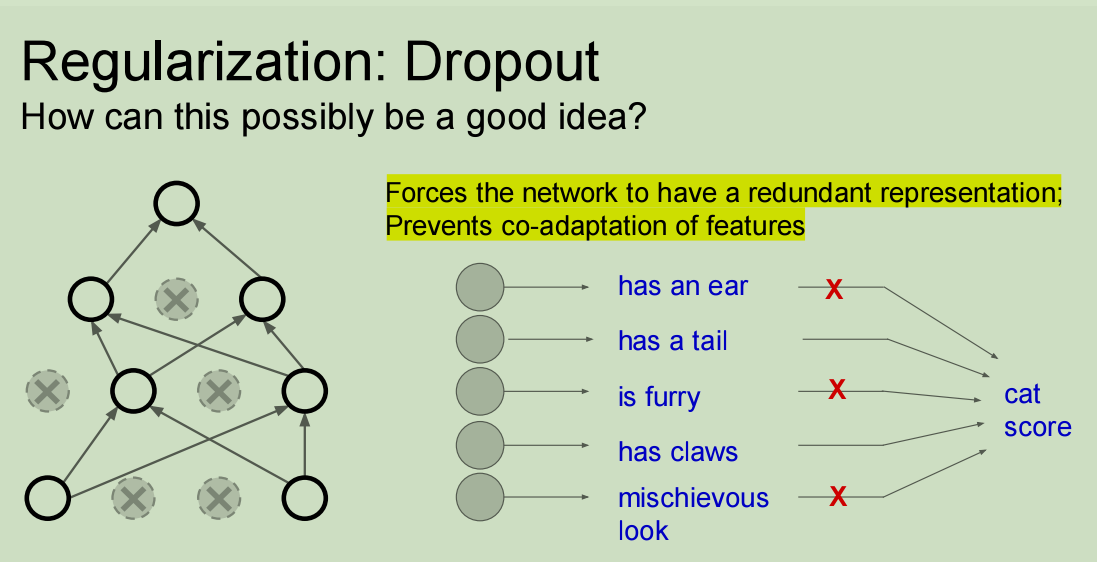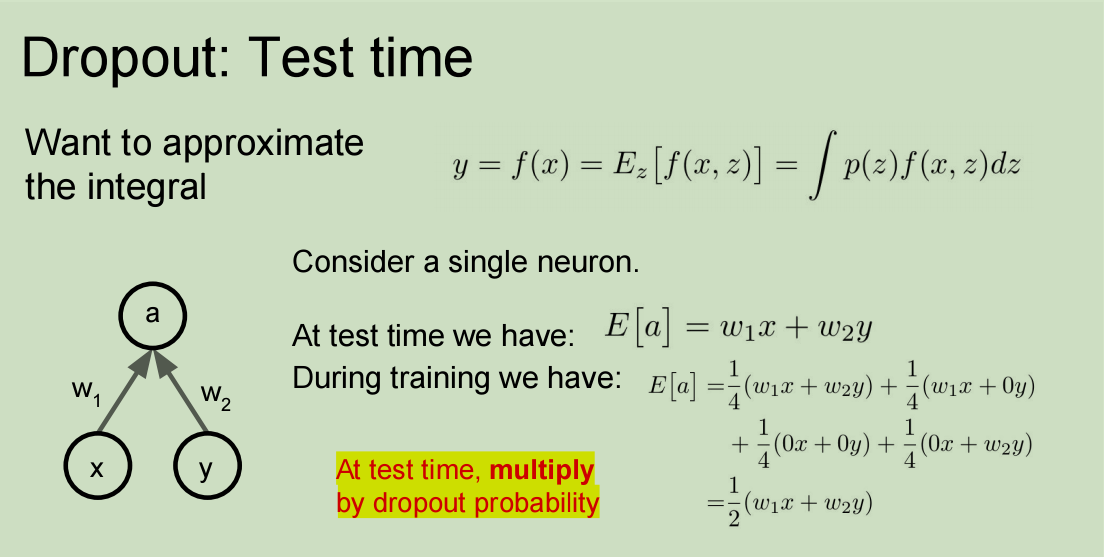Batch Normalization&Dropout浅析
一. Batch Normalization
对于深度神经网络,训练起来有时很难拟合,可以使用更先进的优化算法,例如:SGD+momentum、RMSProp、Adam等算法。另一种策略则是高改变网络的结构,使其更加容易训练。Batch Normalization就是这个思想。
为什么要做Normalization?
神经网络学习过程本质就是为了学习数据分布,一旦训练数据与测试数据的分布不同,那么网络的泛化能力也大大降低;另外一方面,一旦每批训练数据的分布各不相同(batch梯度下降),那么网络就要在每次迭代都去学习适应不同的分布,这样将会大大降低网络的训练速度。
机器学习方法在输入数据为0均值和单位方差的不相关特征时效果更好,所以在我们训练网络的时候,可以人为与处理数据,使其满足这样的分布。然而即使我们在输入端处理好数据,经过更深层次的非线性激活后,数据可能不再是不相关的,也不是0均值单位方差了,这样对于后面网络层的拟合就造成了困难。更糟糕的是,在训练过程中,每个层的特征分布随着每一层的权重更新而改变。
深度神经网络中的特征分布变化会使神网络的训练变得更加困难,为了克服这种问题,在网络中加入Batch Normalization层。在训练时,BN层计算批数据每个特征的均值和标准差。这些均值和标准差的平均值在训练期间被记录下来,在测试阶段,使用这些信息进行标准化测试集特征。
实现方法:

代码实现:
def batchnorm_forward(x, gamma, beta, bn_param):
"""
Forward pass for batch normalization.
During training the sample mean and (uncorrected) sample variance are
computed from minibatch statistics and used to normalize the incoming data.
During training we also keep an exponentially decaying running mean of the
mean and variance of each feature, and these averages are used to normalize
data at test-time.
At each timestep we update the running averages for mean and variance using
an exponential decay based on the momentum parameter:
running_mean = momentum * running_mean + (1 - momentum) * sample_mean
running_var = momentum * running_var + (1 - momentum) * sample_var
Note that the batch normalization paper suggests a different test-time
behavior: they compute sample mean and variance for each feature using a
large number of training images rather than using a running average. For
this implementation we have chosen to use running averages instead since
they do not require an additional estimation step; the torch7
implementation of batch normalization also uses running averages.
Input:
- x: Data of shape (N, D)
- gamma: Scale parameter of shape (D,)
- beta: Shift paremeter of shape (D,)
- bn_param: Dictionary with the following keys:
- mode: 'train' or 'test'; required
- eps: Constant for numeric stability
- momentum: Constant for running mean / variance.
- running_mean: Array of shape (D,) giving running mean of features
- running_var Array of shape (D,) giving running variance of features
Returns a tuple of:
- out: of shape (N, D)
- cache: A tuple of values needed in the backward pass
"""
mode = bn_param['mode']
eps = bn_param.get('eps', 1e-5)
momentum = bn_param.get('momentum', 0.9)
N, D = x.shape
running_mean = bn_param.get('running_mean', np.zeros(D, dtype=x.dtype))
running_var = bn_param.get('running_var', np.zeros(D, dtype=x.dtype))
out, cache = None, None
if mode == 'train':
#######################################################################
# TODO: Implement the training-time forward pass for batch norm. #
# Use minibatch statistics to compute the mean and variance, use #
# these statistics to normalize the incoming data, and scale and #
# shift the normalized data using gamma and beta. #
# #
# You should store the output in the variable out. Any intermediates #
# that you need for the backward pass should be stored in the cache #
# variable. #
# #
# You should also use your computed sample mean and variance together #
# with the momentum variable to update the running mean and running #
# variance, storing your result in the running_mean and running_var #
# variables. #
#######################################################################
sample_mean = x.mean(axis = 0)
sample_var = x.var(axis = 0)
x_hat = (x-sample_mean)/(np.sqrt(sample_var+eps))
out = gamma*x_hat+beta
running_mean = momentum * running_mean + (1 - momentum) * sample_mean
running_var = momentum * running_var + (1 - momentum) * sample_var
#cache = (x,gamma,beta)
cache = (gamma, x, sample_mean, sample_var, eps, x_hat)
#######################################################################
# END OF YOUR CODE #
#######################################################################
elif mode == 'test':
#######################################################################
# TODO: Implement the test-time forward pass for batch normalization. #
# Use the running mean and variance to normalize the incoming data, #
# then scale and shift the normalized data using gamma and beta. #
# Store the result in the out variable. #
#######################################################################
x_h = (x-bn_param["running_mean"])/(np.sqrt(bn_param["running_var"]+eps))
out = gamma*x_h+beta
#######################################################################
# END OF YOUR CODE #
#######################################################################
else:
raise ValueError('Invalid forward batchnorm mode "%s"' % mode)
# Store the updated running means back into bn_param
bn_param['running_mean'] = running_mean
bn_param['running_var'] = running_var
return out, cache
def batchnorm_backward(dout, cache):
"""
Backward pass for batch normalization.
For this implementation, you should write out a computation graph for
batch normalization on paper and propagate gradients backward through
intermediate nodes.
Inputs:
- dout: Upstream derivatives, of shape (N, D)
- cache: Variable of intermediates from batchnorm_forward.
Returns a tuple of:
- dx: Gradient with respect to inputs x, of shape (N, D)
- dgamma: Gradient with respect to scale parameter gamma, of shape (D,)
- dbeta: Gradient with respect to shift parameter beta, of shape (D,)
"""
dx, dgamma, dbeta = None, None, None
###########################################################################
# TODO: Implement the backward pass for batch normalization. Store the #
# results in the dx, dgamma, and dbeta variables. #
###########################################################################
gamma, x, sample_mean, sample_var, eps, x_hat = cache
N = x.shape[0]
D = x.shape[1]
dgamma = np.sum(dout * x_hat,axis = 0)#(D,)
dbeta = dout.sum(axis = 0)#(D,)
dx_hat = dout * gamma#(N,D)
std = np.sqrt(sample_var.reshape(1,D) + eps)#(1,D)
dx = dx_hat / std#(N,D)
dstd = np.sum(-dx_hat*(x_hat/std),axis = 0).reshape(1,D)#(1,D)
dm = np.sum(-dx_hat / std,axis = 0).reshape(1,D)#(1,D)
dvar = dstd/(2*std)#(1,D)
dm += dvar*(-2/N)*((x-sample_mean).sum(axis = 0).reshape(1,D))#(1,D)
dx += dvar * (2/N)*(x-sample_mean)#(N,D)
dx += dm / N#(N,D)
###########################################################################
# END OF YOUR CODE #
###########################################################################
return dx, dgamma, dbeta
二. Dropout
过拟合一直是深度神经网络(DNN)所要面临的一个问题:模型只是在训练数据上学习分类,使其适应训练样本,而不是去学习一个能够对通用数据进行分类的完全决策边界。这些年,提出了很多的方案去解决过拟合问题。其中一种方法就是Dropout,由于这种方法非常简单,但是在实际使用中又具有很好的效果,所以被广泛使用。
Dropout 背后的思想其实就是把DNN当做一个集成模型来训练,之后取所有值的平均值,而不只是训练单个DNN。
DNN网络将Dropout率设置为 p,也就是说,一个神经元被保留的概率是 1-p。当一个神经元被丢弃时,无论输入或者相关的参数是什么,它的输出值就会被设置为0。
丢弃的神经元在训练阶段,对BP算法的前向和后向阶段都没有贡献。因为这个原因,所以每一次训练,它都像是在训练一个新的网络。
简而言之:Dropout 可以在实际工作中发挥很好的效果,因为它能防止神经网络在训练过程中产生共适应。
实现方法:



代码实现1:

代码实现2:

- Inverted Dropout(Dropout 改进版)
优点:使得我们只需要在训练阶段缩放激活函数的输出值,而不用在测试阶段改变什么。

在各种深度学习框架的实现中,我们都是用 Inverted Dropout 来代替 Dropout,因为这种方式有助于模型的完整性,我们只需要修改一个参数(保留/丢弃概率),而整个模型都不用修改。
代码实现:
def dropout_forward(x, dropout_param):
"""
Performs the forward pass for (inverted) dropout.
Inputs:
- x: Input data, of any shape
- dropout_param: A dictionary with the following keys:
- p: Dropout parameter. We drop each neuron output with probability p.
- mode: 'test' or 'train'. If the mode is train, then perform dropout;
if the mode is test, then just return the input.
- seed: Seed for the random number generator. Passing seed makes this
function deterministic, which is needed for gradient checking but not
in real networks.
Outputs:
- out: Array of the same shape as x.
- cache: tuple (dropout_param, mask). In training mode, mask is the dropout
mask that was used to multiply the input; in test mode, mask is None.
"""
p, mode = dropout_param['p'], dropout_param['mode']
if 'seed' in dropout_param:
np.random.seed(dropout_param['seed'])
mask = None
out = None
if mode == 'train':
#######################################################################
# TODO: Implement training phase forward pass for inverted dropout. #
# Store the dropout mask in the mask variable. #
#######################################################################
#musk = np.random.rand(*x.shape) >= p
mask = (np.random.rand(*x.shape) >= p) / (1 - p)
out =x * mask
#######################################################################
# END OF YOUR CODE #
#######################################################################
elif mode == 'test':
#######################################################################
# TODO: Implement the test phase forward pass for inverted dropout. #
#######################################################################
out = x
#######################################################################
# END OF YOUR CODE #
#######################################################################
cache = (dropout_param, mask)
out = out.astype(x.dtype, copy=False)
return out, cache
def dropout_backward(dout, cache):
"""
Perform the backward pass for (inverted) dropout.
Inputs:
- dout: Upstream derivatives, of any shape
- cache: (dropout_param, mask) from dropout_forward.
"""
dropout_param, mask = cache
mode = dropout_param['mode']
dx = None
if mode == 'train':
#######################################################################
# TODO: Implement training phase backward pass for inverted dropout #
#######################################################################
dx = dout * mask
#######################################################################
# END OF YOUR CODE #
#######################################################################
elif mode == 'test':
dx = dout
return dx
出处:http://www.guoyaohua.com
微信:guoyaohua167
邮箱:guo.yaohua@foxmail.com
本文版权归作者和博客园所有,欢迎转载,转载请标明出处。
【如果你觉得本文还不错,对你的学习带来了些许帮助,请帮忙点击右下角的推荐】






【推荐】国内首个AI IDE,深度理解中文开发场景,立即下载体验Trae
【推荐】编程新体验,更懂你的AI,立即体验豆包MarsCode编程助手
【推荐】抖音旗下AI助手豆包,你的智能百科全书,全免费不限次数
【推荐】轻量又高性能的 SSH 工具 IShell:AI 加持,快人一步
· go语言实现终端里的倒计时
· 如何编写易于单元测试的代码
· 10年+ .NET Coder 心语,封装的思维:从隐藏、稳定开始理解其本质意义
· .NET Core 中如何实现缓存的预热?
· 从 HTTP 原因短语缺失研究 HTTP/2 和 HTTP/3 的设计差异
· 周边上新:园子的第一款马克杯温暖上架
· 分享 3 个 .NET 开源的文件压缩处理库,助力快速实现文件压缩解压功能!
· Ollama——大语言模型本地部署的极速利器
· DeepSeek如何颠覆传统软件测试?测试工程师会被淘汰吗?
· 使用C#创建一个MCP客户端